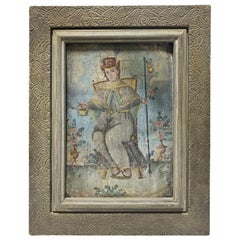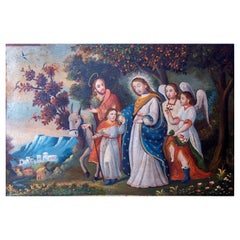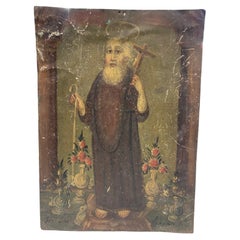Tin Paintings
12
to
1
12
12
12
12
11
11
1
1
1
788
799
720
599
561
12
11
1
Material: Tin
Colonial Mexican Folk Art Ex-Voto Retablo Painting of Mother Mary & Jesus, 1800s
Located in Studio City, CA
A beautiful 19th-century Spanish Colonial Mexican Folk Art ex-voto retablo lámina painting featuring Mother Mary with the crowned infant Jesus Christ (standing on clouds) in her arms...
Category
19th Century Mexican Folk Art Antique Tin Paintings
Materials
Metal, Tin
Spanish Colonial Mexican Folk Art Ex-Voto Retablo Painting Catholic Saint 1800s
Located in Studio City, CA
A beautiful 19th-century Spanish Colonial Mexican Folk Art ex-voto retablo lámina painting featuring an unknown Spanish Roman Catholic Saint.
The work is hand-painted on metal (li...
Category
19th Century Mexican Folk Art Antique Tin Paintings
Materials
Metal, Tin
Colonial Mexican Folk Art Ex-Voto Retablo Painting of Santo Niño de Atocha 1800s
Located in Studio City, CA
A beautiful 19th-century Spanish Colonial Mexican Folk Art ex-voto retablo lámina painting featuring Santo Niño de Atocha (also known as - Holy In...
Category
19th Century Mexican Folk Art Antique Tin Paintings
Materials
Metal, Tin
Enchanting Folk Art Painting of Rooster on Tin
Located in Hopewell, NJ
Enchanting self taught art from Kentucky of a country rooster with the words Fresh Eggs scrawled boldly, all on distressed tin mounted on board. Was probably used as a roadside sign.
Category
1950s American Folk Art Vintage Tin Paintings
Materials
Tin
19th Century Mexican Religious Retablo
Located in Ross, CA
Antique Mexican retablo made in 1890 which includes a woman praying to the Virgin Mary and Jesus Christ.
Framed in wooden frame ornately carve...
Category
1890s Mexican Folk Art Antique Tin Paintings
Materials
Tin
Colonial Mexican Folk Art Ex-Voto Retablo Painting of Saint Rita De Cascia 1800s
Located in Studio City, CA
A beautiful 19th century Spanish Colonial Mexican Folk Art ex-voto retablo lámina painting featuring Saint Rita De Cascia. Santa Rita is almost always depicted as she is here, with a trickle of blood and a thorn deeply embedded in her forehead. According to legend, in the year 1441, during a sermon on the Crown of Thorns, Santa Rita prayed so intently that a thorn detached itself from her crucifix and lodged itself in her forehead. For the next fifteen years, she bore this external sign of stigmatization and union with Christ. It was said her wound became so disturbing to view, that she spent the latter part of her life in isolation and prayer. At her canonization ceremony in the year 1900, Santa Rita de Cascia was bestowed the title of Patroness of Impossible Causes. In Mexico, Santa Rita is widely venerated as the Patroness Saint of mothers, abused wives, and heartbroken women. In this work, she is flanked by two small male figures representing her two beloved sons (notice the fine attention to the paintings of their faces and their glowing rosy red cheeks). She holds a large crucifix in one hand and a flagella whip, symbolizing her practice of mortifying the flesh, in her other hand.
The work is hand painted on metal (likely tin). Ex-votos and retablos are often placed above the altars in churches or family shrines as votive offerings made in the form of religious pictures...
Category
19th Century Mexican Folk Art Antique Tin Paintings
Materials
Metal, Tin
19th C. Mexican Retablo, C.1880
Located in San Francisco, CA
ABOUT
An original 19th century Mexican folk retablo. Oil paint on tin. Subject unknown.
CREATOR Unknown.
DATE OF MANUFACTURE c.1880.
MATERIALS AND TECHNIQUES Oil Paint on Tin.
CONDITION Good. Wear consistent with age and use.
DIMENSIONS H 14 in. W 10 in.
HISTORY
Retablos, better known as 'laminas' in Mexico, are small oil paintings on tin, wood and sometimes copper which were used in home altars to venerate the almost infinite number of Catholic saints. The literal translation for 'retablo' is 'behind the altar.' This unique genre of art, deeply rooted in European history, was brought to Mexico with the arrival of the Spanish and then ultimately adopted by New World mestizo natives to become what is known today as the Mexican folk retablo.
The retablo was an art form that flourished in post conquest Mexico and then ultimately, with the introduction of inexpensive mediums such as tin, reached its pinnacle of popularity in the last quarter of the 19th century. With some exceptions, mostly untrained artists from the provinces worked to produce and reproduce these sacred images; some subjects painted more prolifically than others. A typical "retablero" may have reproduced the same image hundreds, if not thousands of times in his or her career.
These oil paintings were sold to devout believers who displayed them in home altars to honor their patron saints. There are virtually hundreds of saints, each invoked to remedy a different situation. "San Ysidro Labrador," the patron saint of farmers, is venerated for good weather...
Category
19th Century Mexican Folk Art Antique Tin Paintings
Materials
Tin
19th C. Mexican Retablo Saint Francis c.1880
Located in San Francisco, CA
About
An original 19th century Mexican folk retablo of Saint Francis. Oil paint on tin.
St. Francis of Assisi, Italian San Francesco d’Assisi was born 1181-1182 in Assisi, duchy of Spoleto, Italy and died October 3, 1226. He was canonized July 16, 1228. He founded the Franciscan orders of the Friars Minor and the lay Third Order. He was also a leader of the movement of evangelical poverty in the early 13th century. His evangelical zeal, consecration to poverty, charity, and personal charisma drew thousands of followers. Francis’s devotion to the human Jesus and his desire to follow Jesus’ example reflected and reinforced important developments in medieval spirituality.
Cretor Unknown.
Date of manufacture c.1880.
Materials and techniques Oil Paint on Tin.
Condition Good. Wear consistent with age and use.
Dimensions H 14 in. W 10 in.
History
Retablos, better known as 'laminas' in Mexico, are small oil paintings on tin, wood and sometimes copper which were used in home altars to venerate the almost infinite number of Catholic saints. The literal translation for 'retablo' is 'behind the altar.' This unique genre of art, deeply rooted in European history, was brought to Mexico with the arrival of the Spanish and then ultimately adopted by New World mestizo natives to become what is known today as the Mexican folk retablo.
The retablo was an art form that flourished in post conquest Mexico and then ultimately, with the introduction of inexpensive mediums such as tin, reached its pinnacle of popularity in the last quarter of the 19th century. With some exceptions, mostly untrained artists from the provinces worked to produce and reproduce these sacred images; some subjects painted more prolifically than others. A typical "retablero" may have reproduced the same image hundreds, if not thousands of times in his or her career.
These oil paintings were sold to devout believers who displayed them in home altars to honor their patron saints. There are virtually hundreds of saints, each invoked to remedy a different situation. "San Ysidro Labrador," the patron saint of farmers, is venerated for good weather...
Category
19th Century Mexican Folk Art Antique Tin Paintings
Materials
Tin
19th C. Mexican Retablo "Veronica's Veil", c.1880
Located in San Francisco, CA
About
An original 19th century Mexican folk retablo "Veronica's Veil" or "El Divono Rostro" in Spain . Oil paint on tin.
The Veil of Veronica, known in Italian as the Volto Santo or Holy Face, is a Roman Catholic Relic which, according to legend, bears the likeness of the Face of Jesus that was imprinted on it prior to Jesus' crucifixion. According to Roman Catholicism, Saint Veronica encountered Jesus in Jeruselum on the way to Calvary. When she paused to wipe the sweat (Latin, suda) off his face with her veil, his image was left on the veil.
In the small village of Osa de la Vega in Spain, there lived a couple who led a very pious life. They were Gregorio de la Torre and Isabel Corral. From their father, Juan Montilla, they inherited a picture of the Face of Jesus or the Divino Rostro. A story that is told one day, to the amazement of many who confirmed its veracity, the picture began to perspire with living blood. News of this extraordinary event spread swiftly and widely throughout the land.
CREATOR Unknown.
DATE OF MANUFACTURE c.1880.
MATERIALS AND TECHNIQUES Oil Paint on Tin.
CONDITION Good. Wear consistent with age and use.
DIMENSIONS H 14 in. W 10 in.
HISTORY
Retablos, better known as 'laminas' in Mexico, are small oil paintings on tin, wood and sometimes copper which were used in home altars to venerate the almost infinite number of Catholic saints. The literal translation for 'retablo' is 'behind the altar.' This unique genre of art, deeply rooted in European history, was brought to Mexico with the arrival of the Spanish and then ultimately adopted by New World mestizo natives to become what is known today as the Mexican folk retablo.
The retablo was an art form that flourished in post conquest Mexico and then ultimately, with the introduction of inexpensive mediums such as tin, reached its pinnacle of popularity in the last quarter of the 19th century. With some exceptions, mostly untrained artists from the provinces worked to produce and reproduce these sacred images; some subjects painted more prolifically than others. A typical "retablero" may have reproduced the same image hundreds, if not thousands of times in his or her career.
These oil paintings were sold to devout believers who displayed them in home altars to honor their patron saints. There are virtually hundreds of saints, each invoked to remedy a different situation. "San Ysidro Labrador," the patron saint of farmers, is venerated for good weather...
Category
19th Century Mexican Folk Art Antique Tin Paintings
Materials
Tin
19th c. Mexican Retablo "Veronica's Veil" c.1880
Located in San Francisco, CA
ABOUT
An original 19th century Mexican folk retablo "Veronica's Veil" or "El Divono Rostro" in Spain . Oil paint on tin.
The Veil of Veronica, known in Italian as the Volto Santo or Holy Face, is a Roman Catholic Relic which, according to legend, bears the likeness of the Face of Jesus that was imprinted on it prior to Jesus' crucifixion. According to Roman Catholicism, Saint Veronica encountered Jesus in Jeruselum on the way to Calvary. When she paused to wipe the sweat (Latin, suda) off his face with her veil, his image was left on the veil.
In the small village of Osa de la Vega in Spain, there lived a couple who led a very pious life. They were Gregorio de la Torre and Isabel Corral. From their father, Juan Montilla, they inherited a picture of the Face of Jesus or the Divino Rostro. A story that is told one day, to the amazement of many who confirmed its veracity, the picture began to perspire with living blood. News of this extraordinary event spread swiftly and widely throughout the land.
CREATOR Unknown.
DATE OF MANUFACTURE c.1880.
MATERIALS AND TECHNIQUES Oil Paint on Tin.
CONDITION Good. Wear consistent with age and use.
DIMENSIONS H 14 in. W 10 in.
HISTORY
Retablos, better known as 'laminas' in Mexico, are small oil paintings on tin, wood and sometimes copper which were used in home altars to venerate the almost infinite number of Catholic saints. The literal translation for 'retablo' is 'behind the altar.' This unique genre of art, deeply rooted in European history, was brought to Mexico with the arrival of the Spanish and then ultimately adopted by New World mestizo natives to become what is known today as the Mexican folk retablo.
The retablo was an art form that flourished in post conquest Mexico and then ultimately, with the introduction of inexpensive mediums such as tin, reached its pinnacle of popularity in the last quarter of the 19th century. With some exceptions, mostly untrained artists from the provinces worked to produce and reproduce these sacred images; some subjects painted more prolifically than others. A typical "retablero" may have reproduced the same image hundreds, if not thousands of times in his or her career.
These oil paintings were sold to devout believers who displayed them in home altars to honor their patron saints. There are virtually hundreds of saints, each invoked to remedy a different situation. "San Ysidro Labrador," the patron saint of farmers, is venerated for good weather...
Category
19th Century Mexican Folk Art Antique Tin Paintings
Materials
Tin
Santa Rita Retablo
Located in Santa Monica, CA
This late 19th century Mexican Folk Art devotional painting depicts St. Rita of Casia, the patron saint of lost and improbable causes.
Wishing to join an Augustinian convent ...
Category
19th Century Mexican Spanish Colonial Antique Tin Paintings
Materials
Tin
Colonial Mexican Folk Art Ex-Voto Retablo Painting of Saint Francis, 1800s
Located in Studio City, CA
A beautiful 19th-century Spanish Colonial Mexican Folk Art ex-voto retablo lámina painting featuring Saint Francis of Assisi, the Catholic patron saint of animals, birds, and the env...
Category
19th Century Mexican Folk Art Antique Tin Paintings
Materials
Metal, Tin
Related Items
1850 Mexican Colonial Style Oil on Copper Religious Painting
Located in Marbella, ES
Antique 1850 Mexican colonial style oil on copper religious painting.
Category
Mid-19th Century Mexican Antique Tin Paintings
Materials
Copper
Vintage Folk Art Winter Snow Landscape Long Format Painting
Located in Seguin, TX
Antique circa 1915 oil on wood board folk art winter forest scene painting, wood is from an old tobacco crate . Signed Rozella D'Hizar. Unframed, edge wear.
Category
Early 20th Century American Folk Art Tin Paintings
Materials
Wood, Paint
19th Century Italian Naive Flower Painting
Located in Vosselaar, BE
A anonymous Italian 19th century flower painting, oil on wood. The flowers in a gold colored bouquet vase with a scrolled base. Resting o...
Category
Mid-19th Century Italian Antique Tin Paintings
Materials
Wood
Swedish 19th Century Folk Art Oil Painting With Kids
Located in Haddonfield, NJ
Swedish naive oil painting with the original frame, from the 2nd part of the 19th Century.
This folk art work on canvas represents kids and a dog playing by a courtyard, opening the...
Category
Late 19th Century Swedish Folk Art Antique Tin Paintings
Materials
Canvas, Wood
Original Signed Folk Art Painting by Robyn “The Beaver” Beverland
By Robyn Beverland
Located in Atlanta, GA
Unique original signed Folk Art painting by Robyn “The Beaver” Beverland. Signed and dated 1992. Measures: 22" x 12". Artist bio: Robyn “The Beaver” Beverland found great joy in many things but what he most loved was painting. Robyn painted his Folk Art pictures...
Category
1990s American Folk Art Tin Paintings
Materials
Plywood
Folk Art Mountain Landscape Painting - Initialed & Dated - Canada - Circa 1956
Located in Chatham, ON
Mid Century folk art mountain landscape oil painting on artist's canvas board - unframed - initialed lower right - Canada - circa 1956.
Good vintage condition - no loss - no apparen...
Category
Mid-20th Century Canadian Folk Art Tin Paintings
Materials
Canvas, Paint
H 9 in W 12 in D 0.13 in
Spanish Colonial Cuzco Painting of Archangel Michael
Located in Pasadena, CA
This is a very good Spanish Colonial, Cuzco School (Cuzqueno) painting of the Archangel Michael. The painting appears to have little or no restorations and, as such, is in remarkable condition. We have chosen to leave that painting as found as the patina highlights the depth and character of the painting. We have listed separately two complementary larger paintings of the Virgin Mary and the Archangel Michael acquired from the same estate.
The Cuzco school is a Peruvian Spanish Colonial religious artistic tradition in which Incan spirituality was incorporated into Catholic iconography. These Peruvian paintings incorporate artistic forms that distinguish Cuzqueno paintings from other Spanish Colonial artistic traditions. The Jesuit order, arriving in the mid-16th century, was the principal Catholic order whose mission it was to convert the Inca to Christianity and introduce Christian iconography and European type painting techniques to the Inca capital of Cuzco.
Cuzco School paintings...
Category
Mid-18th Century Peruvian Spanish Colonial Antique Tin Paintings
Materials
Canvas, Wood, Paint
Antique Pair of Folk Art Collages Paintings of Partridges in Tramp Art Frames
Located in Munich, DE
This charming pair of collages of a male and a female partridge has been skilfully made out of feathers. The game birds have been set in a colourful landscape surround painted in watercolours. The paintings have been mounted by the last owners in oat coloured passe - partouts with white boardes...
Category
1880s Austrian Folk Art Antique Tin Paintings
Materials
Feathers
H 11.82 in W 14.97 in D 1.58 in
African Ethiopian Tribal Folk Art Painting 20th Century
Located in Milan, IT
Ancient Ethiopian painting imported to Italy by a diplomat during the Italian occupation of Ethiopia, in the late 1930s. This genre scene painting is divided into eighteen squares bordered by a black frame and divided into three lines. The scene depicts the story of a couple with three children through the stories of their domestic life and their rural activity; each box has a caption written in the Amharic language. In the first line: they grind; they drink; …illegible… while they spin; they bring water.
In the second line: comb, cut your hair; treats your teeth; grind; they bring the wood; they bring water.
In the third section: they prepare beer; they prepare bread; they cook bread; they prepare lunch; while they eat; while they drink. This canvas is painted in shades of ocher and is mounteed on a ebonized frame. Dates back to the late 1930s. The canvas show minimal tears and signs of wear but we can customize a restoration.
The human figures are characterized by unrealistic proportions of the head and body and depicted in static positions. This sense of fixity and the narration in successive chapters in domestic environments make the paintings easily intelligible and suggestive.
A particularly fascinating aspect of Ethiopian art...
Category
Mid-20th Century Ethiopian Folk Art Tin Paintings
Materials
Canvas
Colonial Mexican Folk Art Ex-Voto Retablo Painting of Jesus Angel Saint 1800s
Located in Studio City, CA
A beautiful 19th-century Spanish Colonial Mexican Folk Art ex-voto retablo lámina painting featuring a crucified Jesus Christ, angel, or saint (possibly Saint Sebastian who was a Rom...
Category
19th Century Mexican Folk Art Antique Tin Paintings
Materials
Wood, Paint
H 11.75 in W 8.75 in D 0.5 in
19th Century American Folk Art Oil Painting Landscape Sailboats On River
Located in Stamford, CT
A 19th century American folk art oil painting on canvas depicting a river scene at dawn with a horse and rider on a bridge over a waterfall. A castle in the distance and sailboats on...
Category
Mid-19th Century American Folk Art Antique Tin Paintings
Materials
Canvas
Vintage Folk Art Ship on River Landscape Long Format Painting
Located in Seguin, TX
Antique circa 1915 oil on wood board folk art river scene with ship flying American flag painting, wood is from an old tobacco crate. Unsigned. ...
Category
Early 20th Century American Folk Art Tin Paintings
Materials
Wood, Paint
Previously Available Items
Colonial Mexican Folk Art Ex-Voto Retablo Painting of Saint Francis, 1800s
Located in Studio City, CA
A beautiful 19th-century Spanish Colonial Mexican Folk Art ex-voto retablo lámina painting featuring Saint Francis of Assisi, the Catholic patron saint of animals, birds, and the env...
Category
19th Century Mexican Folk Art Antique Tin Paintings
Materials
Metal, Tin
Antique Mexican Retablo "Our Lady of Sorrow"
Located in San Francisco, CA
About
An original early 20th century Mexican folk retablo depecting "Our Lady of Sorrows". A dagger pierces the grieving Virgin Mary's heart referencing...
Category
Early 20th Century Mexican Folk Art Tin Paintings
Materials
Tin
1940s Mexican Gene Byron Tin Brass Framed Polychrome Rooster Chicken Art Tile
By Gene Byron
Located in Dayton, OH
1940’s mid century ceramic hand painted rooster tile by Gene Byron, framed in a tin and brass tooled dish or tray shaped frame.
Measures: 6” x 1.5” x 6...
Category
1940s Folk Art Vintage Tin Paintings
Materials
Brass, Tin
H 6.25 in W 6 in D 1.5 in
Original Mexican Retablo "Exvotos" Oil on Tin
Located in Mexico City, CDMX
Dated 1937, we offer this original exvoto. This artwork features a man who says thanks to San Antonio to do a miracle to save him from certain death by the bite of a scorpion. The piece translates to: 1937 I was bitten by a scorpion, I prayed to Saint Anthony and I did not die, Ostotipaquillo jalisco, Benito canales Urrieta Perez.
Votive paintings...
Category
1930s Mexican Folk Art Vintage Tin Paintings
Materials
Tin
Original Mexican Retablo "Exvotos" Oil on Tin
Located in Mexico City, CDMX
Original oil painting on tin by unknown artist, circa 1914.
Category
1910s Mexican Folk Art Vintage Tin Paintings
Materials
Tin
Retablo of "El Nino de Atocha", 19th Century
Located in Pasadena, CA
This is a finely painted retablo depicting The Christ child as "El Nino de Atocha" on heavy gauge tin set in a wooden frame.
Category
Mid-19th Century Mexican Spanish Colonial Antique Tin Paintings
Materials
Tin
Folk Art Painting of a Pug, England, circa 1890
Located in Culver City, CA
Folk Art painting of a pug, England, circa 1890.
Oil on tin of a pug with a landscape painted on canvas, framed within a rosewood shadow box; the ...
Category
1890s English Victorian Antique Tin Paintings
Materials
Tin
19th Century Folk Art Mischievous Punch and Disgruntled Pooch Oil on Tin Box
Located in Lowestoft, GB
Unusual oil on tin of a mischievous looking punch with a disgruntled pooch, mid-19th century in age English in origin. The tin lid, where the painting is has two simple hinges (both ...
Category
Mid-19th Century English Folk Art Antique Tin Paintings
Materials
Tin
H 2.37 in W 8.27 in D 5.32 in
19th Century, Mexican Retablo, on Tin, "Our Lady of Fatima", or "of The Cave"
Located in Van Nuys, CA
This large, Mexican Retablo is likely of "Our Lady of Fatima" although an old tag on the backside of the framing suggests it is "Our Lady of The Cav...
Category
Late 19th Century Mexican Spanish Colonial Antique Tin Paintings
Materials
Tin
H 17.38 in W 13.5 in D 1.5 in
19th Century Mexican Retablo Painting on Tin of St. Jerome and the Lion
Located in Van Nuys, CA
A Retablo painted on tin, in a period, wooden, black, shadowbox frame, missing its picture glass. The Retablo itself is in extremely distressed condition, missing paint, and an amoun...
Category
Late 19th Century Mexican Spanish Colonial Antique Tin Paintings
Materials
Tin
19th Century Retablo, St. Isidro Painted on Tin, in Original Embossed Tin Frame
Located in Van Nuys, CA
This painted Retablo on tin is in a distressed tin frame, very likely original to the piece. The tin edged frame encases glass over painted foil. The le...
Category
Mid-19th Century Mexican Spanish Colonial Antique Tin Paintings
Materials
Tin
H 20 in W 11 in D 0.13 in
18th Century Naive Portrait on Tin
Located in Dallas, TX
A naive portrait, 18th century, oil on tin of a seated woman dressed in white with white voile ruff and bonnet. A baby in right arm and small child standing beside her on left, also ...
Category
18th Century English Folk Art Antique Tin Paintings
Materials
Tin
Recently Viewed
View AllMore Ways To Browse
Armoire With Three Drawers
Architectural Chest Of Drawers
French Marble Top Commode Inlaid
Painted Italian Two Door Cabinet
Antique Pine Glass Cabinet
Open Shelves Wooden
Pair Walnut Carved Doors
Antique Dresser Commode
Antique Jewelry Cabinet
Antique Jewelry Cabinets
Antique Desk Chest Of Drawers
French Burled Walnut
Antique Marble Top Cupboard
Mid Century Kitchen Wall Cabinet
Used Timber Doors
Pair Of Oak Chests
Dark Green Cabinet
Small Chest With Marble Top









